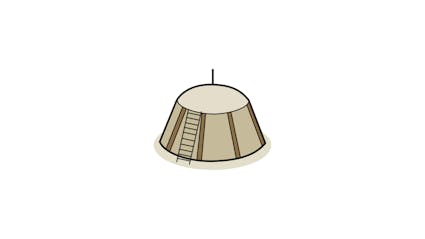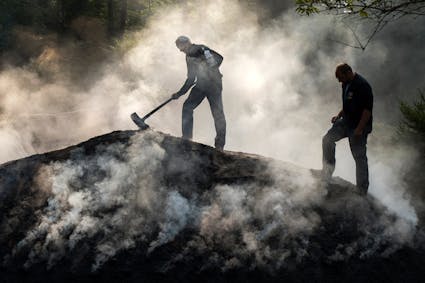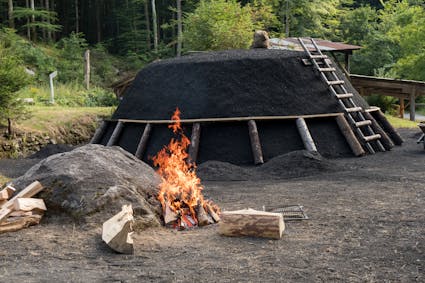493 – Kohlemeiler
In spring, charcoal is produced in the Charcoal Kiln at Ballenberg.

The charcoal trade
Many stories are woven around charcoal burning and charcoal burners. Converting wood into charcoal was a widespread activity in olden days, particularly in forested areas where the transport of wood was a laborious undertaking. Charcoal was much sought after, as it generates a lot of heat and is ideal for melting iron and glass.
The charcoal burners often built their kilns in the middle of the woods where they lived in isolation and very simple circumstances. Many of them were considered to be eccentric, which is not surprising as they were always blackened and covered in soot from their work. They usually only came into the villages to deliver their charcoal, and then all at once they had a lot of money. This life style, which did not correspond to the norm, led people to attribute supernatural powers to charcoal burners and their product. In Entlebuch, for example, there was an oracle-like custom called the Chölele whereby a piece of charcoal swinging on a piece of string at the witching hour gave people answers to the urgent questions they asked.

A visit to a charcoal kiln
The most suitable type of wood for charcoal making is a hard wood such as beech. Firstly the wood is sawn into lengths (Rugel). To build the kiln, the lengths of wood are layered in an upright position around a pole erected in the middle. The pile of wood, which is about three metres high, is covered with foliage or pine branches. It is then sealed off by a layer of materials left over from previous burnings mixed with earth, about twenty centimetres in thickness, the so-called “Löschi”. Before lighting the kiln the wooden pole in the middle is removed and the space is filled with red-hot charcoal. The charcoal burner must now take care not to let the glowing charcoal embers fade out or, on the contrary, burn too strongly. He controls the air intake by opening and closing draught holes. The charring process for 50 steres of wood lasts about 10 to 12 days and produces around 4 tonnes of charcoal.

Ballenberg
Swiss Open-Air Museum
Museumsstrasse 100
CH-3858 Hofstetten bei Brienz
Company holidays
24 December 2025 to 11 January 2026
Opening hours Administration
3 November 2025 to 8 April 2026
From Monday to Friday
8.30 am to 11.30 am
1.30 pm to 4.30 pm
Opening hours
9 April to 1 November 2026
10 am to 5 pm daily